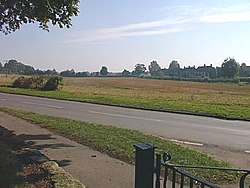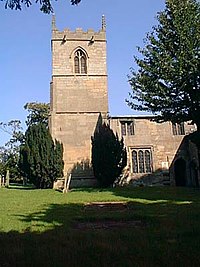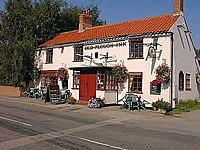Egmanton
| Egmanton | |
| Nottinghamshire | |
|---|---|
 Egmanton from the church gate | |
| Location | |
| Grid reference: | SK733687 |
| Location: | 53°12’41"N, -0°53’58"W |
| Data | |
| Population: | 286 (2011) |
| Post town: | Newark |
| Postcode: | NG22 |
| Dialling code: | 01777 |
| Local Government | |
| Council: | Newark and Sherwood |
| Parliamentary constituency: |
Newark |
Egmanton is a small, farming village in Nottinghamshire, a mile south of Tuxford and a mile north of Laxton. The nearest larger towns are Retford and Newark-on-Trent. The population of the civil parish taken at the 2011 Census was 286.
The name of the village is from the Old English Ecgmundes tun, meaning 'Ecgmund's farm/settlement'.
Parish church

The parish church, St Mary's, has parts dating back to Anglo-Saxon times. The church today has a chancel, clerestoried nave, a north aisle of four bays, a south transept and a west tower. The windows in the south transept are late fourteenth century. The west tower was built in the 15th century.[1] Romanesque features are a plain south doorway, the north arcade and the font.[2] The three bells in the tower are by the foundry of John Taylor & Co.
Before the Reformation, the church contained a shrine to the Virgin Mary, after a reported apparition of Mary to a local woman in nearby Ladywood, at some time before the 12th century. This Shrine was a destination for pilgrimages in the Middle Ages, and pilgrim crosses are still found in the church, scratched by medieval pilgrims to mark the completion of a vow, by the south door and in the north isle.[3] [1] The shrine was destroyed in 1547 at the Reformation, and pilgrimages were stopped.
In the 1890s the patron of the parish, the 9th Duke of Newcastle, began a restoration. As he was a keen partisan of the Tractarian movement in the Church of England, it took a more Anglo-Catholic form, and at some time before 1922 he has 1922, he sold the patronage of Egmanton to the Society for the Maintenance of Faith, an Anglo-Catholic body within the Church of England. By this time pilgrims had begun to visit Egmanton and its rebuilt shrine[4] In 1930, Alfred Hope Patten rebuilt another shrine, at Little Walsingham, and led a pilgrimage to Egmanton. The Society of Our Lady of Egmanton organizes several pilgrimages every year.[1]
The church itself is more commonly known these days by a distinctly unreformed name, as 'the Church of Our Lady of Egmanton'.
History
Egmanton appears in the Domesday Book of 1086 as among the possessions of Roger de Busli.
The village was part of the Lordship and Liberty of Rufford, a liberty granted to the extensive estates of Rufford Abbey.
About the village

Egmanton Castle consists of the remains of a motte and bailey style castle. It is commonly known as Gaddick Hill.
To the west of the village off Kirton road are some earthworks which are the remains of mediæval fish ponds, now dry.
A tower windmill was located at the southern end of Mill Lane (SK733683).
Oil fields
Oil has been produced from the East Midlands oil fields since 1939 with some production wells located around Egmanton. Although many have now closed, some of these wells remain in production to this day. On a national scale the level of production was never significant.
Outside links
| ("Wikimedia Commons" has material about Egmanton) |
References
- ↑ 1.0 1.1 1.2 History: The Society of Our Lady of Egmanton
- ↑ St Mary, Egmanton, Nottinghamshire: The Corpus of Romanesque Sculpture in Britain and Ireland
- ↑ Church of Our Lady of Egmanton: Derbyshire and Nottinghamshire Medieval Graffiti Survey
- ↑ Southwell Churches: Egmanton
